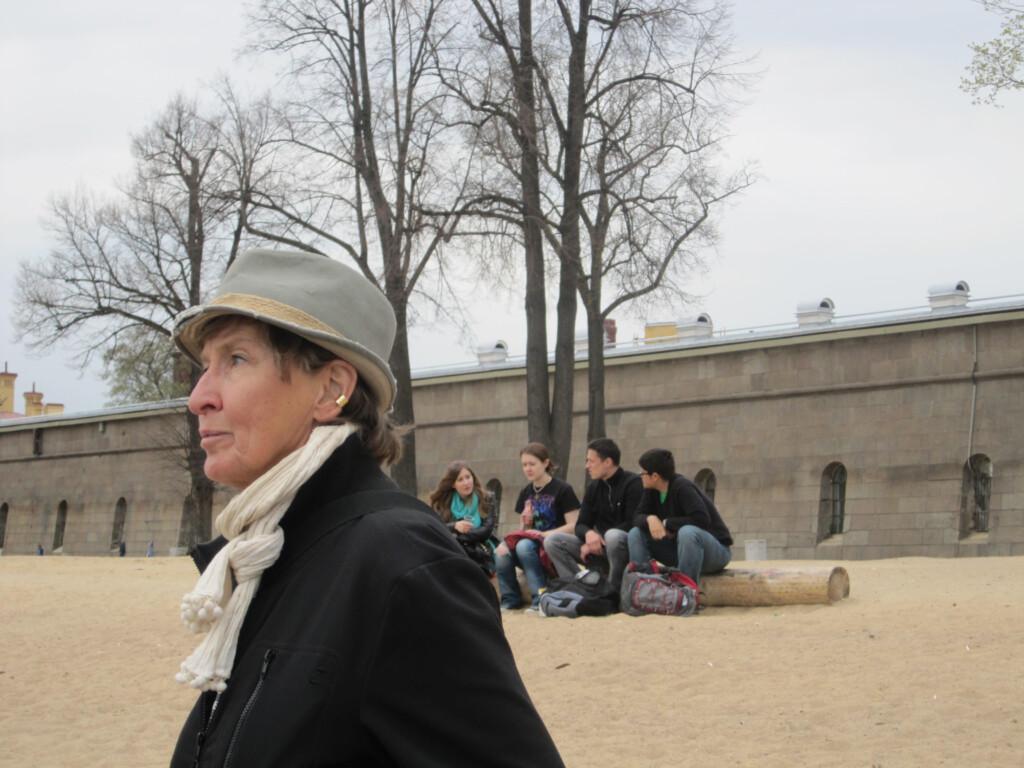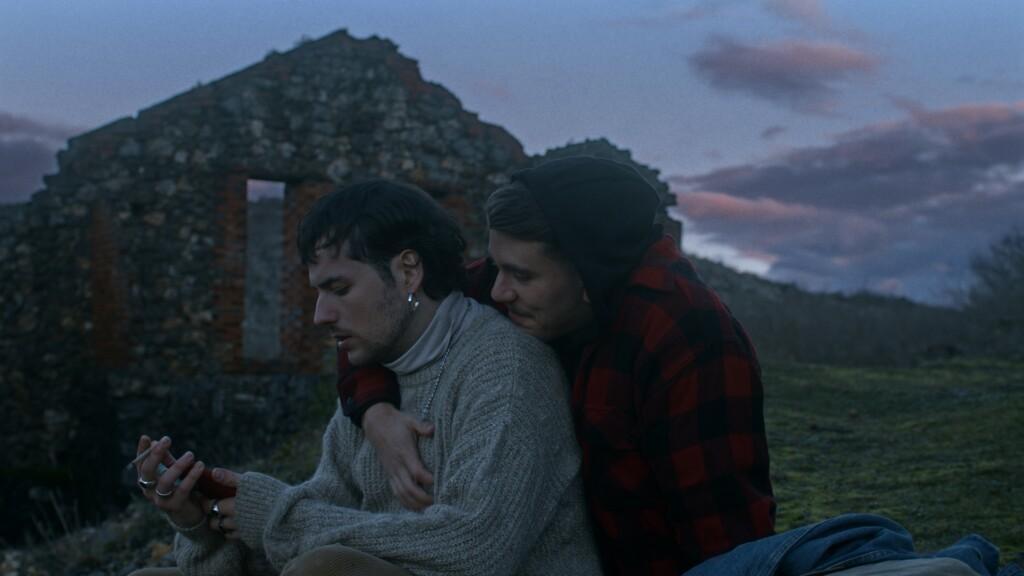Pirjo Honkasalo and That Which You Can’t Say
Director Pirjo Honkasalo moves fluently between fact and fiction, but has no interest in stories. “I think I have a Ural kind of head,” she says.

Pirjo Honkasalo in Saint Petersburg in 2011. Photo: Kati Sinisalo
WRITTEN BY
Kati Sinisalo
Producer at YLE Kulttuuri and Curator for YLE Teema Film Festival, former film journalist
When boiled down to its essence – when it’s at its most liberated – what is film? Having made both fiction and documentary films for over 50 years, Pirjo Honkasalo has found the answer. But you can’t really say it.
And still, this interview tries to do just that. And instead of a linear story, it goes back and forth.
Let’s start with the story.
A shared element in both Honkasalo’s fictive works and documentaries is a resignation from traditional storytelling. She points out that the concept of a story is entirely informed by our culture. Hollywood has spread the same dramaturgic tradition to all parts of the world, though traditional Finnish story-telling isn’t usually too linear.
“They say that the languages of the Ural mountains, which use grammar modifiers, create a story through relations. Stories go back and forth. They were created in forests. Indo-European languages rely on prepositions, and came about in steppes. There, a story requires that forward-moving momentum, linear storytelling. I think I have a Ural kind of head.
“These days everything’s a story. I’ve never been interested in them. There are stories in my films, but they’ve never been the starting point or the end goal. I’m not even that good at listening to stories.
“I also don’t remember a single famous line from a movie. Apparently I’ve been preoccupied by watching someone in the background.
“A film can be made without a story, or its story can be built off of real human lives. A story can arise from the way you carry thoughts and feelings, how you seek them out, the tensions they hold; from the mirrored images of the meaning of life.”
Honkasalo says she loves words, though living with a writer has taught her to tone that side of herself down a bit. “And Pirkko Saisio used to take really great pictures before we knew each other. Not anymore!
“But in film, I don’t look for words. Image and sound are the first means of expression for me. A film can express what words can’t. To me, that’s the beauty of film, the thing that makes me passionate about it.”
“Human beings have divorced from themselves and become objects of their own selves”
According to Honkasalo, documentary filmmaking is fundamentally immoral. It’s an ethical extreme sport. This is what separates it from fiction.
“What gives you the right to express yourself through other people’s lived experiences, even when they consent to it? A documentarian mixes real, living human beings on their palette. It’s kind of odd, ethically speaking. You can justify fiction because it’s made up: everyone knows this isn’t actually happening.
“Then again, people have a desire to be seen, especially now when it’s normal to be nonreligious. It used to be that people were seen by their gods, now they’re kind of not seen by anyone. That’s why they may agree to do something they shouldn’t.
“Human beings have divorced from themselves and become objects of their own selves, only seen by themselves, analysed by themselves. This creates a state of emptiness and meaninglessness. That, too, makes the part of a documentarian an ethically tricky one. Who’s speaking through her?
“No matter the setup, the ethical responsibility of a documentary film falls on its director. You have no way of knowing what you’ll end up having to be responsible for when you start making a film. Doing this takes either great courage or a great deal of obliviousness.
“Documentary films may also lead to real-life consequences for people. How do I take the ethical responsibility for that? It’s impossible.”
Honkasalo says that the only way you can afford to justify this moral weight is by respecting the humanity of your subject.
“Luckily the people being filmed will let you know if you’re being respectful. If you’re not worth anything, they shut down. People aren’t stupid. If you observe and read people as a director, you shouldn’t think they’re not reading you right back.”
“This Sudden Feeling of Life Force, This Return to a Great Connection”
So what is it that this extreme sport tries to gain? Moments of truth that exist beyond words. Meaning what, and how?
“You mean, how can a film reach that which can’t be verbalised? Putting it into words is awkward.”
Let’s try it anyway. Honkasalo has written this part down to make sure she’ll get it right.
“When Ingmar Bergman was over 80 years old, he was asked if experience makes the work of a director any easier. He said that capturing a single moment of truth in film is always every bit as difficult. What is a moment of truth? To me, it’s capturing even one single moment of animal silence in a person. You don’t get that through closeness, you get that with distance.
“If you love your subject the way a documentarian filming a person should love them, you have to both be them and be separate from them at the same time. These opposites existing simultaneously doesn’t really fit into a Western world view.
“You also have to love the other person’s separate being and their solitude, their quiet. You have to dare to keep your distance. You can’t intrude upon another person’s solitude or you’ll destroy it. If you step in, it’s no longer solitude. Films might offer a careful reflection of that.
“Recognising that you’re one and the same, and the feeling of intimacy brought about from that recognition, is the first stage of likeness, the requirement for art. You can only achieve the second stage of likeness through distance. In art you can say it appears as this sudden feeling of life force, this return to a great connection. Its path is always present in the immaterial world.
“The greatest thing about film is that through it, you can reach this path. But you can’t plan or prepare for it. If one succeeds in reaching it, they aren’t aware of it themselves.
“That’s what’s most fascinating about film. Experience won’t help you.”
“One has the eye of an ornithologist, the other sees the souls of those who’ve passed”
Honkasalo says that a documentarian should lust for that which they fear, and go towards that which they cannot understand. “You have to let go of thinking that your own feelings and reactions are right. It makes observing the world around you quite interesting!
“My interest in documentary film was probably influenced by my mother. She was a social worker. Back then, home visits were very common, and I tagged along with her – which probably wasn’t actually allowed. That made the different realities between different people very apparent to me from a young age.
“That’s where I also got this certain type of fearlessness. In those times the protocol was that an unsafe situation was first seen to by a social worker, then the police, and as a last resort, a doctor. I might have been a shield for my mother, but I never felt – to use a current expression – that my safe space was at risk.
“Maybe that’s the attitude of every documentarian: to just get in there!”
Acquiring the trust of your subjects, however, is just the beginning of the journey. People don’t realize what they’ve gotten themselves into. They get tired halfway through.
“Documentary films are often finished out of sheer pity, when the subjects see the crew working themselves to death,” laughs Honkasalo.
“You also need to be quick and creative. We were filming Chechen children in Ingushetia for The 3 Rooms of Melancholia. We had a five-person crew. When we hit a bad day, everyone was exhausted. Our producer Kristiina Pervilä disappeared and came back with five chickens. The children were encouraged to name the chickens after us. They played with them, mocked them, and mimicked us. After that, everyone felt better and we continued. That was one creative producer!”
Working in other cultures emphasizes these challenges. When filming Atman, Honkasalo hoped to reach at least one moment where she saw the world as the disabled Indian man in front of the camera.
“His state of mind was completely different from mine, it was symbiotic, seamless. The way Western people view life as a part of all of creation is at the very least fractured, if not destroyed completely.
“Say we both look at the birds in the sky – what do we see? Our view of the sky is completely different: one has the eye of an ornithologist, the other sees the souls of those who’ve passed flying in the sky.”
“The lack of glamour has been a huge blessing to the industry”
Though in many ways this task is impossible, Honkasalo says you shouldn’t back down from it. It’s a huge possibility to see the world in a different light.
“Documentary filmmakers have actually made it through this ethical challenge remarkably well.”
Honkasalo posits that this is due not only to the instinct to observe inherent in documentarians, but also because you learn from experience – the good and the bad. That, and the lack of glamour in the industry.
“At documentary festivals, there’s stern discussions about what the world is like. Fiction festivals too often discuss how and where to get money and success. The lack of glamour has been a huge blessing to the industry. Obviously filmmakers want to succeed and make good films, but their career awareness isn’t too intense.”
After Honkasalo won the Main Prize at Bombay Film Festival with Tanjuska and the 7 Devils in 1994, she was given the chance to see Indian filmmaking in action. At a Bollywood studio she met a movie star, dressed in a maroon silk shirt, with a bleeding woman being draped around his shoulders.
When the man heard that Honkasalo makes documentaries, he lost interest, saying:
“Well, if you want to make classroom films, you can make classroom films.”
But documentary filmmaking is greatly rewarding work. A fine and demanding profession, says Honkasalo. And it takes humility, unlike making fiction.
Does that mean that Pirjo Honkasalo, the fiction filmmaker, is different from Pirjo Honkasalo, the documentarian?
“If I look at the themes present in my fiction and documentaries, I do see the same head at work. Possibly even the same heart. But of course the production setups are very different from each other, you’re looking at five truckfulls of lighting equipment versus five chickens in Ingushetia.
“With documentary film, you go into the great unknown and return enriched. With fiction, you give from that which you’ve already lived. Of course you also give through documentaries, the filmmaker’s gaze has its own past, its own grief and sorrow and joy. But with making fiction, I’ve collected a vault that I use for it.”
“I don’t pitch, I’m not a bitch”
For a moment, let’s return to the dusty memories of classroom films and the bright future of documentary film.
Honkasalo, too, remembers the scratchy 16 mm educational films that everyone gathered to watch at the school’s assembly hall. “Documentary smelled of old clothes, even the very word itself.”
But now we’re in a situation where documentary film is interesting, tempting and prestigious. It’s hot and trendy – even a little glamorous!
“We must beware of that,” says Honkasalo.
“Documentary film is doing fine. Actually it’s blown right open, spread out in every direction. It can be abstract or anything at all. You don’t have to draw specific limitations on it.”
You also shouldn’t draw lines when deciding on how to finance your work.
“Pitching is an unavoidable American tradition which favours easy stories, being able to tell what the film is about in ninety seconds. I consider that selling yourself. I’m going to have a t-shirt made that says on the back: ‘I don’t pitch, I’m not a bitch.’
“On a serious note, the danger in pitching is that young filmmakers are so hungry to make something, they’re intelligent, and they know what kind of pitch gets them what they want. It might have the same effect as self-censorship. And then you don’t pitch films like The 3 Rooms of Melancholia.”
“Once the Finnish Film Foundation asked me what the target audience for Melancholia was. I said it’s weepy middle-aged men, no one does anything for them!”
This is an updated version of an interview originally made for DocPoint Film Festival in 2022. English translation by Aaro Salokorpi, TFF.
Read more about Pirjo Honkasalo’s retrospective and Carte blanche screening at Tampere Film Festival 2025. Hear from Honkasalo directly at a symposium titled Pirjo Honkasalo: Film and Philosophy on 7 March 2025, or at her masterclass held 8 March 2025.

The Tampere Film Festival Office is on Holiday in July
Summer is here, and so are the holidays! The Tampere Film Festival office is on holiday

The Manse Pride 2025 Screening by Tampere Film Festival Takes Place on Wednesday 11 June
The short film screening TFF GOES MANSE PRIDE: ECHOES OF BROKEBACK MOUNTAIN will be presented as part of the Manse Pride 2025 week.
